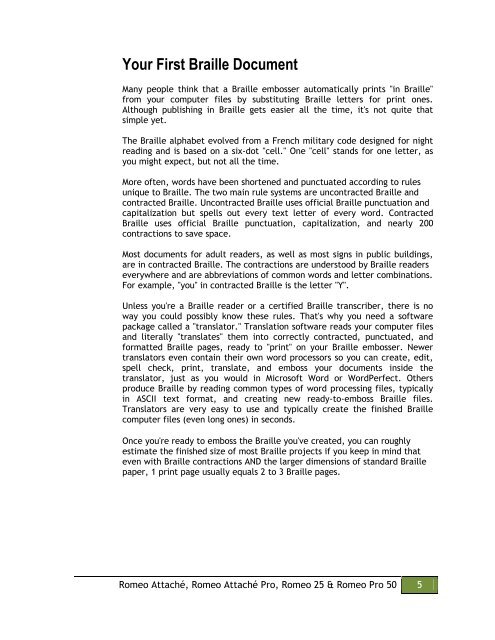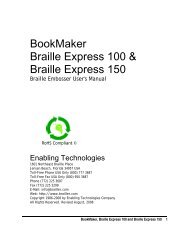Romeo Attaché Romeo Attaché Pro Romeo 25 & Romeo Pro 50
Romeo Attaché Romeo Attaché Pro Romeo 25 & Romeo Pro 50
Romeo Attaché Romeo Attaché Pro Romeo 25 & Romeo Pro 50
Create successful ePaper yourself
Turn your PDF publications into a flip-book with our unique Google optimized e-Paper software.
Your First Braille DocumentMany people think that a Braille embosser automatically prints "in Braille"from your computer files by substituting Braille letters for print ones.Although publishing in Braille gets easier all the time, it's not quite thatsimple yet.The Braille alphabet evolved from a French military code designed for nightreading and is based on a six-dot "cell." One "cell" stands for one letter, asyou might expect, but not all the time.More often, words have been shortened and punctuated according to rulesunique to Braille. The two main rule systems are uncontracted Braille andcontracted Braille. Uncontracted Braille uses official Braille punctuation andcapitalization but spells out every text letter of every word. ContractedBraille uses official Braille punctuation, capitalization, and nearly 200contractions to save space.Most documents for adult readers, as well as most signs in public buildings,are in contracted Braille. The contractions are understood by Braille readerseverywhere and are abbreviations of common words and letter combinations.For example, "you" in contracted Braille is the letter "Y".Unless you're a Braille reader or a certified Braille transcriber, there is noway you could possibly know these rules. That's why you need a softwarepackage called a "translator." Translation software reads your computer filesand literally "translates" them into correctly contracted, punctuated, andformatted Braille pages, ready to "print" on your Braille embosser. Newertranslators even contain their own word processors so you can create, edit,spell check, print, translate, and emboss your documents inside thetranslator, just as you would in Microsoft Word or WordPerfect. Othersproduce Braille by reading common types of word processing files, typicallyin ASCII text format, and creating new ready-to-emboss Braille files.Translators are very easy to use and typically create the finished Braillecomputer files (even long ones) in seconds.Once you're ready to emboss the Braille you've created, you can roughlyestimate the finished size of most Braille projects if you keep in mind thateven with Braille contractions AND the larger dimensions of standard Braillepaper, 1 print page usually equals 2 to 3 Braille pages.<strong>Romeo</strong> <strong>Attaché</strong>, <strong>Romeo</strong> <strong>Attaché</strong> <strong>Pro</strong>, <strong>Romeo</strong> <strong>25</strong> & <strong>Romeo</strong> <strong>Pro</strong> <strong>50</strong> 5









